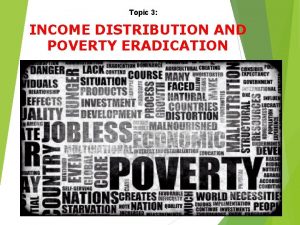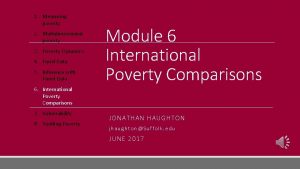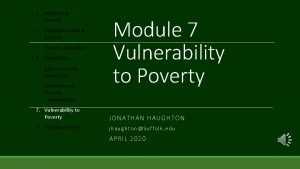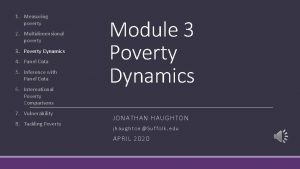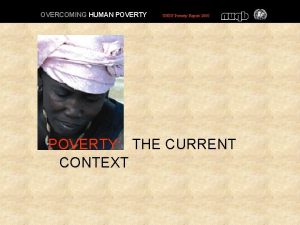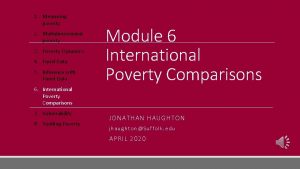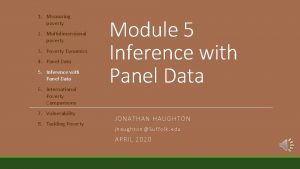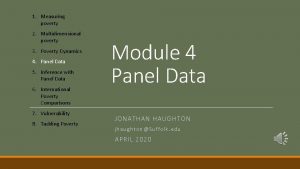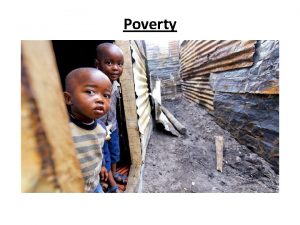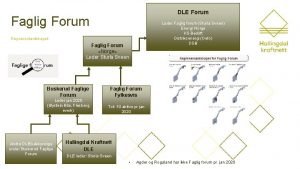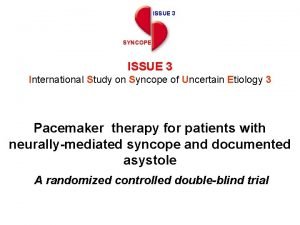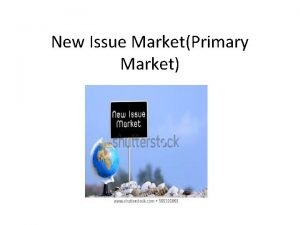FOOD POVERTY FORUM The Issue of Food Poverty

























- Slides: 25

FOOD POVERTY FORUM The Issue of Food Poverty Dr Sinéad Furey 10 January 2019 ulster. ac. uk @Dr. Sinead. Furey #Food. Poverty. UUBS

Overview The issue of food poverty • • Food poverty and the right to food Statement of the problem The growing problems of food poverty and insecurity Northern Ireland in context Measuring food poverty UUBS Civic Impact research findings Conclusion Acknowledgements

Food Poverty A definition… Food Poverty “The inability to consume an adequate quality or sufficient quantity of food for health, in socially acceptable ways, or the uncertainty that one will be able to do so. ” (Radimer et al. , 1990)

Right to Food • Universal Declaration of Human Rights, 1948 (Article 25) enshrines the right to food • International Covenant on Economic, Social and Cultural Rights (1966) • Convention on the Rights of the Child (1989) ⁻ Both explicitly name adequate food and housing as basic human rights. • Sustainable Development Goals (UN, 2015) ⁻ No Poverty and Zero Hunger • We need to protect this right and address the gap between income and food costs

Statement of the problem • Food poverty: the inability to afford or access a healthy diet • Short-term and long-term effects • Result: food poverty = a public health emergency • Food banks = rapid increase and demand for assistance • ‘Governmentality’ around food has shifted:

Food poverty in the UK • The UK is the fifth richest country in the world yet we face a growing epidemic of hidden hunger with people increasingly unable to meet their family’s basic needs. • UK food poverty has all the signs of a public health emergency that could go unrecognised until it is too late to take preventive action [British Medical Journal, December 2013]. • Food poverty has overtaken healthy eating as a most pressing public health concern. • “Some people in the country are not being able to eat at all and if people can’t eat at all, what’s the point in trying to get them to eat healthily? ” [Derbyshire County Council, 2014].

The growing problems of food poverty and insecurity • Food banks have increased over the past 10+ years • The context for the rise in food banks are rises in food poverty due to: – Insufficient income – Benefit delays – Benefit Changes – Debt – Increasing essential cost of living (housing and utility bills)

Reliance on food banks • UK Government does not officially monitor food bank usage • 345 Trussell Trust food banks – the number is insufficient – need between 400 and 650 more to cope with expected demand • Tripling of people reliant on food banks since 2012 • Over 350, 000 people in the UK are reliant on food aid – 35% of these are children [Trussell Trust, 2013] • This figure could rise to over 500, 000 people when also accounting for the work of non-Trussell Trust affiliated organisations [Church Poverty in Action & Oxfam, 2013] • Geographical gaps in coverage means thousands of people are facing hunger today in towns with no food banks • We cannot ignore the hunger on our doorstep

Why do people rely on food banks? Changes to the benefits system Unemployment Increasing levels of underemployment Low and falling incomes Sickness (including mental health issues and addictions) Debt: Loan sharks / payday loans Rising food prices Rising fuel prices Homelessness Domestic violence

Food poverty - NI “For most developed nations many health, social and economic indicators suggest things have never been better. Generally, life expectancy is high, national wealth is on an upward trajectory and food is in abundance. Why is it then, that in a rich country like Northern Ireland almost 30 per cent live in poverty and many marginalised and socially disadvantaged groups are often without a nutritious and enjoyable diet, suffering the associated poor health and social consequences? Northern Ireland, like the Republic of Ireland, does indeed experience food poverty and this is shameful” (Foreword by Sharon Friel, WHO Commission on Social Determinants of Health)

Food poverty in NI (2006 – 2007) Aim - to document the state of food poverty in Northern Ireland. The authors anlaysed food consumption and expenditure data, the current policy environment and interviewed key stakeholders and conducted focus groups with those experiencing/at risk of food poverty. There are numerous policies already in existence which, if successfully implemented, will address some of the fundamental causes of food poverty.

Measuring food poverty No accepted food poverty indicator Typically use EU-SILC Food Deprivation Measures Levels of deprivation based on: – Minimum Income Standard – Level of deprivation

NI in context Poverty 18% living in relative poverty, before housing costs (Department for Communities, 2018). Food Security 5% had not eaten a substantial meal at least one day in the last fortnight due to a lack of money. Rises to 10% for the most deprived quintile (Department of Health, 2017). Low income households spend more than their higher income counterparts on food and non alcoholic drinks (13. 6% cf. 7. 8%; average = 10. 5%).

UUBS food poverty research Aim and approach • To disseminate an online survey comprising three existing food poverty / household food insecurity indicators to determine if there is good agreement in terms of food poverty outcomes from two or more indicators for NI households. • EU-SILC (4 food deprivation measures) • Food Insecurity Experience Scale (8 -item measure) • Household Food Security Scale Module (adult 10 -item measure and child 8 -item measure) • Ethical approval for online survey was gained for September to November (2018) period • Data analysed using SPSS • A total sample size of 944 (N = 944) was gained - overall good variation to responses

UUBS food poverty research Survey sample • The majority (78. 7%) were employed full/part time or selfemployed; the remainder comprised retired (8. 1%); unemployed (4. 9%)’; students (3. 2%) and homemakers (3. 2%). • One in twelve (8%) had a total household income (salary and benefits) of less than £ 10, 000 and more than half (52. 9%) had a household income of less than £ 39, 999 each year. • One in 14 (7. 4%) of the total sample self-evaluated their health status as poor. • Two in five respondents (41. 9%) had children aged under 18 years living in their households

UUBS food poverty research Emerging results EU-Survey on Income and Living Conditions (4 food deprivation measures): • One in three (34. 4%) experienced at least one measure of food deprivation. Food Insecurity Experience Survey (8 -item scale): • One in three 35. 7% (278/779) reported experiencing at least one food poverty measure concerned with eating less healthy foods or skipping meals etc. Household Food Security Scale Module (10 -item adult measure; 8 -item child measure): • One in five (21. 2%; 133/628) reported experiencing at least one food poverty measure concerned with worry about running out of food or not eating enough. • 79 households with children confirmed experiencing at least one food poverty measure.

Emerging results continued EU-SILC (4 -item scale) No (0) positive responses to food deprivation measures: 65. 6% 1 positive response to food deprivation measures: 10. 1% 2 positive responses to food deprivation measures: 10. 1% 3 positive responses to food deprivation measures: 7% All (4) positive responses to food deprivation measures: 7. 3% FIES (8 -item scale) • Food secure / Mild food insecurity (0 -3 measures): 84. 1% • Moderate food insecurity (4 -6 measures): 8. 9% • Severe food insecurity (7 -8 measures): 7. 1% HFSSM (10 -item scale) Food secure / Mild food insecurity (0 -1 measures): 88. 1% Moderate food insecurity (2 -5 measures): 7% Severe food insecurity (6 -10 measures): 4. 9%

Emerging results continued • There is good ‘agreement’ between the EU-SILC and FIES food poverty measures. A small minority failed to agree through crosscomparison of indicators. • There is excellent ‘agreement’ between FIES and HFSSM measures. • Therefore, each scale identifies (generally) the same people as experiencing ‘mild’, ‘moderate’ or ‘severe’ food poverty. • So, how did respondents feel about completing each scale? EU-SILC: Easy to answer but restrictive answers FIES: Relevant, clear and simple but some repetition and difficult wording HFSSM: Straightforward, less challenging

Qualitative findings “Because although money is tight in our house we budget so we make sure we always have enough money for food which may mean sacrificing other things, like treats, but feeding our children and ourselves is a priority. ” “Embarrassed at not having money for basics, with both of us working. ” “I know my budget: sometimes 'food' is biscuits. ” “… at present our financial situation is uncomplicated. I fear for the future though. . ” “Based on the last fortnight I have been able to afford meals but, as a working single parent, I worried about feeding my son over the summer and as a result couldn't afford meals for myself. Food is fast becoming an issue for me and it is embarrassing to have to admit that despite working there are still times when you have to go hungry to support your child. You feel entirely responsible. ” “Food bank Friday. ” “It makes me feel terrible to think that some people living in this, one of the wealthiest countries in the world, may not have enough money to have a large meal, or to give gifts of food to their friends and extended family. It makes me feel sick to think about that. ”

Conclusion • Food poverty requires a long-term, sustainable solution • We need to address the policy issues under focus: ü low income; ü under/unemployment; ü rising food prices; and ü Welfare Reform. • Efforts needs to be informed by routine, Government-supported monitoring and reporting of the extent of food poverty among our citizens.

References • Butler, P. (2014) Food poverty now bigger public health concern than diet – expert claims. The Guardian, 03. 14. Available from: https: //www. theguardian. com/society/2014/mar/03/food-banks-public -health-benefits-panorama • Department for Communities. (2018) Poverty bulletin: NI 2016/17. Available from: https: //www. communitiesni. gov. uk/sites/default/files/publications/communities/ni-povertybulletin-201617. pdf • Department of Health. (2017) Health survey for NI – Trend Tables. Available from: https: //www. health-ni. gov. uk/publications/healthsurvey-northern-ireland-first-results-201617 • Downing, E. , Kennedy, S. and Fell, M. (2014) Food banks and food poverty standard note: SN 06657. London; House of Commons Library. P. 8. • Purdy, J. , Mc. Farlane, G. , Harvey, H. , Rugkasa, J. and Willis, K. (2007). Food poverty: Fact or fiction. Food Poverty and Policy in Northern Ireland Cork: safefood.

References • Radimer, K. L. ; Olson, C. M. ; Campbell, C. C. (1990) Development of indicators to assess hunger. Journal of Nutrition 120, 1544– 1548. • Taylor-Robinson, D. , Rougeaux, E. , Harrison, D. , Whitehead, M. , Barr, B. and Pearce, A. (2013) The rise of food povery in the UK. British Medical Journal; 347: f 7157 • United Nations. (2018) About the Sustainable Development Goals. Available from: https: //www. un. org/sustainabledevelopment-goals/ • United Nations. (1989) Convention on the rights of the child. Available from: https: //www. ohchr. org/en/professionalinterest/pages/crc. aspx • United Nations. (1966) International covenant on economic, social and cultural rights. Available from: https: //www. ohchr. org/en/professionalinterest/pages/cescr. asp • UN (1948) The universal declaration of human rights. Available from http: //www. un. org/en/documents/udhr/.

Additional reading • Caraher, M. and Furey, S. (2018) The economics of emergency food aid provision: A financial, cultural and social perspective. London: Palgrave Macmillan. [ISBN 978 -3 -319 -78505 -9] • Caraher, M. and Furey, S. (2017) Is it appropriate to use surplus food to feed people in hunger? Short-term Band-Aid to more deep-rooted problems of poverty. London: Food Research Collaboration. [ISBN 978 -1 -903957 -21 -9] • Furey, S. , Fegan, L. , Burns, A. , Mc. Laughlin, C. , Hollywood, L. and Mahon, P. (2016) An investigation into the prevalence and people’s experience of ‘food poverty’ within Causeway Coast and Glens catchments: Secondary analysis of local authority data. Coleraine: CCAG Glens Borough Council.

Acknowledgements § Martin Caraher, Professor of Food Policy, City, University of London § Emma Beacom, Ulster University § Dr Chris Mc. Laughlin, Institute of Technology, Sligo § Ursula Quinn, Ulster University § Dr Dawn Surgenor, Ulster University § Palgrave Macmillan

Thank you! Any Questions? ms. furey@ulster. ac. uk
 Difference between absolute and relative poverty
Difference between absolute and relative poverty Hát kết hợp bộ gõ cơ thể
Hát kết hợp bộ gõ cơ thể Bổ thể
Bổ thể Tỉ lệ cơ thể trẻ em
Tỉ lệ cơ thể trẻ em Voi kéo gỗ như thế nào
Voi kéo gỗ như thế nào Chụp phim tư thế worms-breton
Chụp phim tư thế worms-breton Chúa sống lại
Chúa sống lại Các môn thể thao bắt đầu bằng tiếng chạy
Các môn thể thao bắt đầu bằng tiếng chạy Thế nào là hệ số cao nhất
Thế nào là hệ số cao nhất Các châu lục và đại dương trên thế giới
Các châu lục và đại dương trên thế giới Công thức tiính động năng
Công thức tiính động năng Trời xanh đây là của chúng ta thể thơ
Trời xanh đây là của chúng ta thể thơ Mật thư tọa độ 5x5
Mật thư tọa độ 5x5 Phép trừ bù
Phép trừ bù Phản ứng thế ankan
Phản ứng thế ankan Các châu lục và đại dương trên thế giới
Các châu lục và đại dương trên thế giới Thơ thất ngôn tứ tuyệt đường luật
Thơ thất ngôn tứ tuyệt đường luật Quá trình desamine hóa có thể tạo ra
Quá trình desamine hóa có thể tạo ra Một số thể thơ truyền thống
Một số thể thơ truyền thống Cái miệng bé xinh thế chỉ nói điều hay thôi
Cái miệng bé xinh thế chỉ nói điều hay thôi Vẽ hình chiếu vuông góc của vật thể sau
Vẽ hình chiếu vuông góc của vật thể sau Nguyên nhân của sự mỏi cơ sinh 8
Nguyên nhân của sự mỏi cơ sinh 8 đặc điểm cơ thể của người tối cổ
đặc điểm cơ thể của người tối cổ Giọng cùng tên là
Giọng cùng tên là Vẽ hình chiếu đứng bằng cạnh của vật thể
Vẽ hình chiếu đứng bằng cạnh của vật thể
